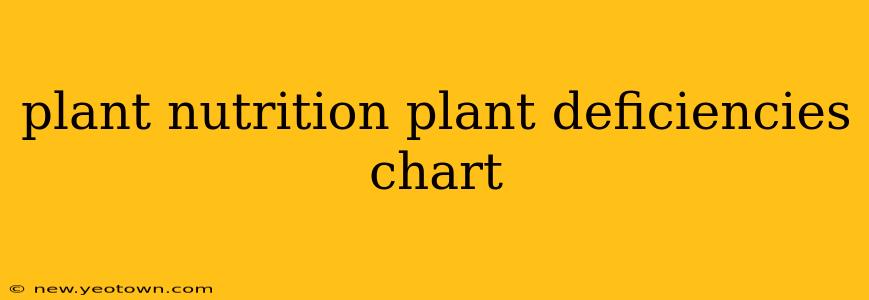Plants, much like us, require a balanced diet to thrive. Their nutritional needs are met through the soil, air, and water. However, understanding plant nutrition and recognizing deficiency symptoms is crucial for any gardener, from seasoned professionals to enthusiastic beginners. This comprehensive guide will delve into the world of plant nutrition, focusing on common deficiencies and their tell-tale signs. We'll unravel the mysteries behind yellowing leaves, stunted growth, and other plant woes, empowering you to diagnose and address these issues effectively.
What are the Essential Nutrients for Plant Growth?
Before we dive into deficiencies, let's establish the foundation: essential plant nutrients. These are elements plants must obtain from their environment to complete their life cycle. They are broadly categorized into macronutrients (needed in larger quantities) and micronutrients (needed in smaller amounts).
Macronutrients:
- Nitrogen (N): Crucial for chlorophyll production (responsible for green color and photosynthesis), amino acid synthesis (building blocks of proteins), and overall plant growth.
- Phosphorus (P): Essential for root development, flowering, fruiting, and energy transfer within the plant.
- Potassium (K): Plays a vital role in regulating water balance, enzyme activation, and disease resistance.
- Calcium (Ca): Important for cell wall structure, cell division, and nutrient uptake.
- Magnesium (Mg): A central component of chlorophyll, essential for photosynthesis.
- Sulfur (S): Involved in protein synthesis and chlorophyll formation.
Micronutrients:
- Iron (Fe): Essential for chlorophyll production and enzyme activity.
- Manganese (Mn): Involved in photosynthesis and enzyme activation.
- Zinc (Zn): Important for enzyme function and growth hormone production.
- Copper (Cu): Plays a role in enzyme activity and chlorophyll formation.
- Boron (B): Crucial for cell wall development and sugar transport.
- Molybdenum (Mo): Essential for nitrogen metabolism.
- Chlorine (Cl): Involved in photosynthesis and stomatal function (regulating gas exchange).
Recognizing Plant Deficiency Symptoms: A Visual Guide
Now, let's tackle the practical aspect – identifying deficiencies through visual cues. Remember that symptoms can vary based on the plant species, the severity of the deficiency, and environmental factors. However, understanding general patterns is extremely helpful.
1. What are the symptoms of nitrogen deficiency?
Nitrogen deficiency often manifests as a general yellowing (chlorosis) of older leaves first. This is because the plant mobilizes nitrogen from older leaves to support newer growth. The yellowing usually starts at the leaf margins and progresses inward. Stunted growth and reduced flowering are also common symptoms.
2. What are the signs of phosphorus deficiency?
Phosphorus-deficient plants often exhibit dark green or purplish discoloration of the leaves, especially the older ones. Growth is stunted, and flowering and fruiting may be reduced or delayed. The leaves may appear dull and lackluster.
3. How do I identify potassium deficiency in plants?
Potassium deficiency typically shows up as yellowing or scorching of leaf margins, often starting at the tips and progressing inward. The leaves may become brittle and susceptible to disease. The plant's overall growth may be stunted.
4. What are the symptoms of a magnesium deficiency?
Magnesium deficiency often results in interveinal chlorosis (yellowing between leaf veins), particularly in older leaves. The leaves may also become chlorotic and exhibit necrotic spots (brown, dead areas).
5. What are the visual clues for iron deficiency?
Iron deficiency is characterized by interveinal chlorosis in young leaves. Unlike magnesium deficiency, the yellowing occurs between the veins of the younger leaves, leaving the veins green. This is because iron is less mobile in the plant than magnesium.
6. How can I tell if my plant has a manganese deficiency?
Manganese deficiency usually presents as interveinal chlorosis in younger leaves, similar to iron deficiency, but it may also show up as speckled or mottled patterns. The symptoms can sometimes be confused with iron deficiency.
7. How do I identify a zinc deficiency?
Zinc deficiency symptoms often include small, distorted leaves with shortened internodes (the spaces between leaf nodes). The leaves may appear chlorotic.
8. What are the symptoms of a boron deficiency?
Boron deficiency can lead to a variety of symptoms, including stunted growth, thick, brittle leaves, and distorted flower or fruit development. The plant's overall appearance is often unhealthy.
9. How can I recognize a copper deficiency?
Copper deficiency can cause wilting, dieback, and stunted growth. Leaves may become chlorotic, and the overall plant health will be compromised.
10. How can I detect a molybdenum deficiency?
Molybdenum deficiency typically manifests as chlorosis and leaf curling. It can also affect nitrogen fixation in plants that rely on symbiotic relationships with nitrogen-fixing bacteria.
Addressing Plant Deficiencies
Once you've identified a deficiency, addressing it is crucial. This typically involves amending the soil with the necessary nutrients. Soil testing is highly recommended to determine the precise nutrient levels. Based on the test results, you can use appropriate fertilizers, either organic or inorganic, to correct the imbalance. Remember that preventing deficiencies through proper soil management and regular fertilization is always the best approach. Healthy soil translates to healthy plants!

